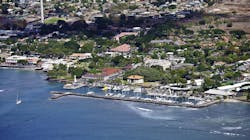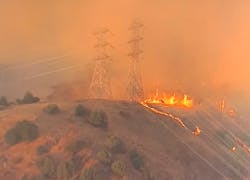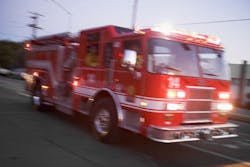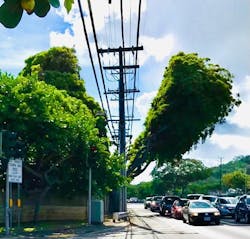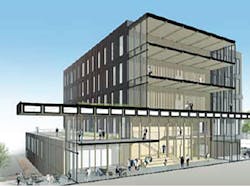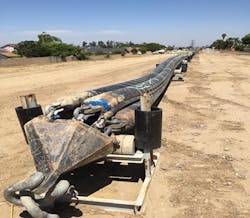By Mike Beehler, Mike Beehler and Associates LLC, and Richard Gasaway, Green Stewardship, LLC
The devastating Aug. 8 fires in Lahaina, Hawaii changed lives forever.
It was a tragedy that deeply saddened the watching world — the loss of lives, and loss of a way of life unique to the beautiful setting that Lahaina and the Island of Maui provided.
Although Lahaina and the people lost can never be replaced, the grieving community already is showing its resolve to build back. How can local Hawaiians safely and affordably rebuild their beautiful homes, reclaim their rich history and restore business vitality among the smoldering ruins of Lahaina town?
Infrastructure starts with energy. Energy lights and conditions homes, schools and commercial buildings, it pumps and purifies water, it provides certain types of transportation and mobility, and is critical to communications and broadband technologies.
Hawaii has ambitious goals for the use of energy that impacts each aspect of rebuilt infrastructure. Hawaii hopes to achieve the use of 100% renewable energy by 2045. Could rebuilding Lahaina help to meet that goal? The answer is yes!
So how can local Hawaiians in Lahaina rebuild a safe, reliable, resilient and affordable net-zero energy electric power generation and delivery system in Lahaina in the short run while planning on 100% renewable in the long run? Rebuilding Lahaina must employ proven approaches to master-planned infrastructure that include strong community input to the use of emerging technologies, zoning and densities; green infrastructure for storm water control, retention and detention; parks and recreation facilities with more native plants and xeriscapes; underground utilities that add system resiliency and beautify the streetscape; and human mobility and transportation features such as pedestrian and bicycling zones and the possible use of electric vehicle charging/ hydrogen fueling capabilities.
This Lahaina-town master plan will include the interconnection of new, highly energy and water efficient residential, commercial and government buildings that use transactive energy to share distributed resources across the grid and “net zero” buildings that over the year, use the energy and water that they produce and potentially store on site.
Net Zero Designs
Hawaii hopes to achieve the use of 100% renewable energy by 2045. This is a hugely ambitious goal that impacts each aspect of the master planned, rebuilt infrastructure. In the short run of the next few years, reaching this goal will start with designing, constructing, operating and maintaining net zero energy buildings. https://www.energy.gov/eere/buildings/zero-energy-buildings-resource-hub
Net zero can be defined several ways. The best definition for early applications is “the net energy or water used for an asset over the course of a one-year period is produced on site.” Buildings, facilities and plants experience peak periods of energy and water use as temperature, humidity, consumer use and production levels vary. During these peak periods, the facility will need to be connected to the electric, gas or water distribution systems (the grid) of the utilities like Maui Electric Company or the Maui County Department of Water Supply. And, current fossil plants connected by 69kV transmission will be needed until reliable energy storage and alternative, clean and dispatchable electric repowering is available. These transmission lines and their substations provide valuable electric infrastructure that will be needed for every other type of infrastructure that Lahaina will rebuild. The transmission lines must be rebuilt quickly and on strong, resilient and fireproof steel poles. The substations must be rebuilt with resiliency in mind.
Underground Utilities
A net zero Lahaina will require a highly reliable and resilient transmission and distribution (T&D) system best delivered by undergrounding the electric distribution system.
Undergrounding offers several advantages compared to overhead lines to include significantly reduced vulnerability to extreme weather events like tsunamis and floods, lightning, hurricanes, and wildfires. By eliminating the impact of future fires, severe weather conditions and reducing other potential outages caused by falling tree limbs or vegetation contact, car hit poles, birds and rodents, mylar balloon impacts, ground line wood rot and more, undergrounding contributes to a much more reliable and resilient electric distribution system.
Today, the electric distribution system in America is approximately 20% underground, and Hawaii in general is pretty close to that. Yet, some public power utilities like Ft. Collins, Colorado Springs, and Anaheim have had underground ordinances for years. They have beautified their cities and improved the performance of their systems. Fort Collins is 99% underground and is 99.9% reliable. Colorado Springs started in the 1970’s and today is 77% underground with 99.9% reliability. Anaheim has been engaged in its Home Underground Program (HUG) since 1990 with excellent results. And, the phone and cable TV utilities in Anaheim paid to go underground as well. In addition, Dominion, WE Energy, PHI, Georgia Power, Florida Power & Light, PG&E and many more public and private utilities are building new 21st-century underground systems to replace antiquated overhead systems and improve system performance and resiliency.
Moreover, the fiber, telecommunications and cable TV will all share same underground trench. High-capacity broadband will enable local community leaders and local entrepreneurs to employ selected new and emerging technologies that bring value to end user customers. Broadband connects people. It harnesses the power of data, turning data into information, and ultimately, action. Theoretically, this connectivity and the resulting data is used to create something new and desirable in our resilient communities including safety and warning features for the citizens of Lahain
Homes, School and Businesses
After basic short term utility infrastructure is in place, construction of homes, schools and commercial businesses can start. Designs for this new construction should include:
- Customer Solar- Integrating rooftop and canopy PV solar to provide power and/or hot water without increasing valuable land usage.
- Customer Storage- Capturing renewable on-site power generation in battery storage systems or even small-scale hydrogen storage in safe, containerized metal-hydride systems.
- Distribution scale battery energy storage (short duration 4 hours or less) – Possibly located at existing power plants, substations or distribution network points and provides a community energy storage aggregation point.
- Strong emphasis on energy efficient designs with heavy insulation in walls and roofs, dual pane or glazed glass, high efficiency heat pumps, and chillers, etc following the principles of LEED (Leadership in Energy and Environmental Design) by the US Green Building Council.
- Native Hawaiian plants and xeriscape provide beautiful, drought tolerant species of colorful ground covers, hardy shrubs and shade giving trees for a rebuilt Lahaina. The University of Hawaii at Manoa has a Cooperative Extension Service that is an excellent resource for owners, planners, landscape architects and contractor
- Demand Side Management (DSM) is a series of rate structures or incentives that provide energy and water customers with financial incentives change their resource use patterns to the benefit of the local utility. Demand Response (DR) is the ability of a utility like Maui Electric to incent aggregated customers (under FERC 2222) or commercial customers to shed load as system needs require load reduction.
100% Renewable by 2045
Once a safe, reliable and resilient T&D system is rebuilt and the community starts to rebuild homes, schools and businesses with state-of-the-art net zero energy and water practices, local leaders in Lahaina, Maui County and the state can start to evaluate other, long-term methods of achieving their final goal of 100% renewable by 2045.
Waste to Energy
Maui’s main landfill handles approximately 450 tons of waste per day for the 100,000 residents plus visitors that inhabit the island. Even with recycling 30% of the refuse, the landfill options are filling. Maui can collect and burn some methane gas from existing landfilled areas, but should consider a small 10-15 mW waste to energy plant. It is a huge challenge to accept the combustion of waste or continue to use valuable land and potentially impact groundwater quality.
Water and Wastewater Treatment
Water and wastewater transportation and treatment is a very energy-intensive process. Lahaina has the potential opportunity to co-locate water and wastewater systems with other utilities using state of the art distribution piping systems that 1) have few if any leaks and 2) detect the size and location of leaks. Potable water delivered to homes, schools and businesses can be used for irrigation or sanitation and treated on site with reverse osmosis systems for drinking, washing, cooking and any other human contact. Reducing the energy used in water and wastewater treatment and transportation will reduce community peak loads and help achieve net zero energy use.
Geothermal
Conventional geothermal resources on Maui could be developed or developers or Maui Electric could use closed loop geothermal technology. Closed loop geothermal provides continuous renewable power production and on a small surface footprint. The difference with closed loop technology is not needing sub-surface water and hot rock at the perfect temperatures and depth, since the fluid cycles in tubes, acting as a heat exchanger to drive the electric generation.
Bio-fuels
Bio-energy and bio-fuels production can be another possible low carbon replacement for fossil fuels in Hawaii’s 2045 plan. Bio fuels can provide sustainable and reliable power for stationery and mobility applications on demand. There are many vacant agricultural fields from old sugar and pineapple production that are overgrown with non-native grasses. These grasses could be harvested to produce biofuels and at the same time cut down on the risk of wildfires.
Hydrogen
In striving for net zero resilient communities, it is hard to “electrify everything” and rely completely on the electron to do the job. That is why more and more communities are looking to clean hydrogen. A low carbon intensity produced molecule, such as green hydrogen can complete the circle, providing sustainable and resilient community infrastructure needs in power, transportation and industry.
Traditionally, hydrogen is produced from methane or water using energy intensive processes to separate the molecular elements. These processes are improving and new and exciting developments for hydrogen are in the “clean” hydrogen space. It can support electric system operations and microgrids in several ways:
Hydrogen can be used as a form of energy storage for electric systems. Excess renewable energy, such as from geothermal, wind or solar, can be used to produce hydrogen through electrolysis. The hydrogen can then be stored and used to generate electricity during times when renewable energy production is low.
Fuel Cells
Bio-fueled fuel cells or hydrogen fuel cells can be used to generate electricity, providing a clean and efficient alternative to traditional combustion-based power generation. In addition, fuel cells can be used to power electric vehicles, homes, schools and businesses. Bio-fueled fuel cells or hydrogen fuel cells can be used to balance the electric grid by providing a flexible source of power that can respond quickly to changes in demand or supply. Hydrogen fuel cells can be used to provide backup power during times of peak demand, reducing the need for fossil fuel-based peaker plants. And, hydrogen fuel cells can be used in addition to batteries to power remote sensors and monitoring equipment on the T&D system. Finally, hydrogen fuel cells can be part of a portfolio of generation, storage and demand side management tools used to successfully operate and maintain net zero energy buildings.
Another opportunity for the greater good could be to tie into the State of Hawaii’s plan to participate in a US Depart of Energy (DOE) hydrogen hub. This of course would require a higher level of coordination at the State level but could positively impact the timeline and scale of greater hydrogen availability.
Undersea Cable
An undersea electrical power cable to the geothermal resources of the Big Island of Hawaii was studied by Hawaiian Electric Company in 1990 and found to be technically feasible. Notwithstanding any cultural issues, perhaps now is the time to implement an undersea cable to Maui and, if that works well, complete it to Oahu. Many long submarine power cables around the world already exist or are currently under construction including:
- The 53-mile Trans Bay cable from Pittsburg, California, to San Francisco.
- The Champlain-Hudson Power Express line will be 339 miles long and carry 1.2 gigawatts, from a Hydro-Quebec substation near the New York State line to Astoria, Queens by 2026.
- The 447-mile North Sea Link, a 1.4-gigawatt cable, transmitting electricity between the north of England and southern Norway
Pumped Storage Hydro
If the geography characteristics are favorable, and siting agreeable to the Lahaina community and Maui in general, pumped water energy storage is still one of the most reliable sources of energy storage.
Small Modular Reactor
Although not in the present Hawaii plan, consider Small Modular Reactor (SMR) nuclear technology to provide carbon-free baseload electrical power and off-peak power to water desalination and electrolysis plants for hydrogen generation.
Local Hawaiians must rebuild their beloved Lahaina town. Rebuilding starts with a good short term and an ambitious long run infrastructure plan. We have explored critical energy infrastructure and demonstrated how innovative energy solutions can impact other critical infrastructure like water, transportation and communications which would be critical to the rebuilding Lahaina-town in the vision of the local people.
While the lives and property lost in the horrible fires can never be replaced, the people of Lahaina can rebuild, reclaim and restore their beloved Lahaina. Together, they can restore charm and character of their homes and make Lahaina a cleaner, safer and more affordable community in the challenging years ahead and then, for decades to come.
Mike Beehler has over 40 years of electric T&D experience at Tucson Electric Power, Hawaiian Electric Company and Burns & McDonnell. He was educated as a civil/structural engineer at the University of Arizona and is a registered professional engineer in eight states including Hawaii. He currently is the founding member and Chief Opportunity Officer of Mike Beehler & Associates, LLC and serves as the National Spokesperson for the Power Delivery Intelligence Initiative https://www.pdi2.org/. Mike is a Fellow in ASCE and a Member of CIGRE and IEEE.
Richard (Rick) Gasaway ([email protected]) is a registered Professional Electrical Engineer in four states and author of the book An Inconvenient Purpose. Gasaway’s first project as an engineer was on the design team of the AES Hawaii Barbers Point Power Plant in 1991. Gasawayand his wife Bonnie honeymooned in Maui, The Big Island, and Oahu, even including a tour of the power plant in 1994 — yes, they are still married.
About the Author
Mike Beehler
Vice President
Mike Beehler P.E., ([email protected] ), is the national spokesperson for the Power Delivery Intelligence Initiative and the chief opportunity officer for Mike Beehler & Associates LLC. He started his career designing and building transmission lines and substations for Tucson Electric Power and the Hawaiian Electric Co. and then spent more than 20 years designing T&D infrastructure and consulting on emerging trends at Burns & McDonnell. He has written, presented and consulted on reliability-centered maintenance, critical infrastructure protection and program management. In addition, he is a well-known industry writer and speaker on the early definition of the smart grid, 3-D and building information modeling applications in T&D, and development plans for smart cities. Most recently, he is sought for his strategic leadership and vision on the application of emerging technologies in changing business models to include the integration of distributed energy resources, augmented/virtual reality and artificial intelligence. He authored the book, The Science of the Sale. Beehler is a registered professional engineer in Arizona, Florida, Hawaii, Texas, Colorado, Kansas, Georgia and Alabama. He also is a Fellow in the American Society of Civil Engineers and a member of IEEE and CIGRE.
Richard Gasaway
Richard (Rick) Gasaway is a registered Professional Electrical Engineer in 4 states and author of the book An Inconvenient Purpose. Rick’s first project an engineer was on the design team of the AES Hawaii Barbers Point Power Plant in 1991. Rick and his wife Bonnie honeymooned in Maui, The Big Island, and Oahu, even including a tour of the power plant in 1994—yes, they are still married.
